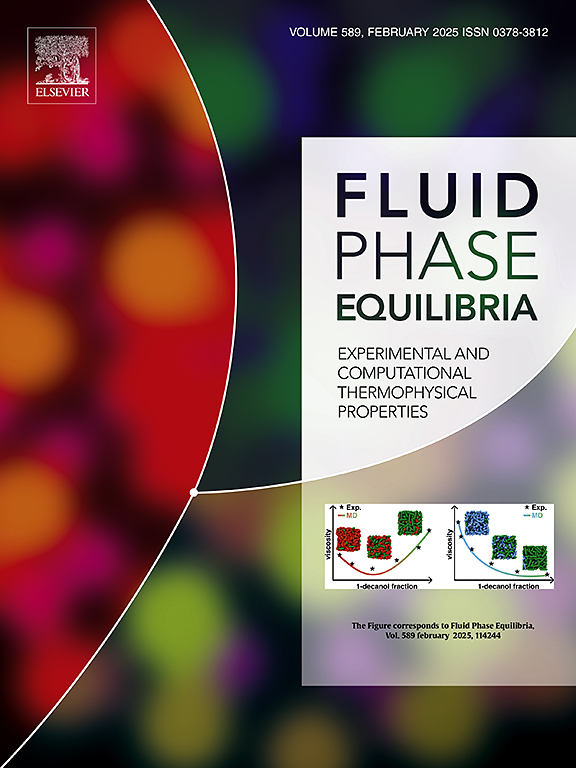Hydrate phase equilibrium of hydrogen with THP, DCM, TBAB+THF and sulfur hexafluoride +TBAB aqueous solution systems
IF 2.8
3区 工程技术
Q3 CHEMISTRY, PHYSICAL
引用次数: 0
Abstract
Experimental hydrogen hydrate dissociation data with single thermodynamic additive: tetrahydropyran (THP, with oxygen-containing functional group) or dichloromethane (DCM, with halogen group), and thermodynamic additive mixtures: tetrahydrofuran (THF) + tetrabutylammonium bromide (TBAB) system and sulfur hexafluoride (SF6) +TBAB system were reported with temperature range from 275.33 to 282.98 K and pressure range from 1.65 to 12.63 MPa. Other experimental data were collected from the literature. The compared results showed that the oxygen-containing or halogen functional group can significantly affect the hydrogen bonding between water molecules, which present great promoting effects on hydrogen hydrates formation. Also, the promoting effects of mixture additives on the phase equilibrium of hydrogen hydrates were investigated. The results indicated that the combination of thermodynamic additives showed better promoting effects on hydrate formation compared to the individual ones. And the results obtained in this work would provide useful information to select suitable and effective thermodynamic additives for hydrate-based hydrogen storage technology.
氢与 THP、DCM、TBAB+THF 和六氟化硫 +TBAB 水溶液体系的水合物相平衡
报告了单一热力学添加剂:四氢吡喃(THP,含氧官能团)或二氯甲烷(DCM,含卤素基团)以及热力学添加剂混合物:四氢呋喃(THF)+四丁基溴化铵(TBAB)体系和六氟化硫(SF6)+TBAB 体系的水合氢解离实验数据,温度范围为 275.33 至 282.98 K,压力范围为 1.65 至 12.63 MPa。33 至 282.98 K,压力范围为 1.65 至 12.63 MPa。其他实验数据来自文献。比较结果表明,含氧或卤素官能团能显著影响水分子之间的氢键,对氢水合物的形成有很大的促进作用。此外,还研究了混合添加剂对氢水合物相平衡的促进作用。结果表明,与单独的添加剂相比,热力学添加剂的组合对水合物的形成具有更好的促进作用。这项研究的结果将为水合物储氢技术选择合适有效的热力学添加剂提供有用信息。
本文章由计算机程序翻译,如有差异,请以英文原文为准。
求助全文
约1分钟内获得全文
求助全文
来源期刊

Fluid Phase Equilibria
工程技术-工程:化工
CiteScore
5.30
自引率
15.40%
发文量
223
审稿时长
53 days
期刊介绍:
Fluid Phase Equilibria publishes high-quality papers dealing with experimental, theoretical, and applied research related to equilibrium and transport properties of fluids, solids, and interfaces. Subjects of interest include physical/phase and chemical equilibria; equilibrium and nonequilibrium thermophysical properties; fundamental thermodynamic relations; and stability. The systems central to the journal include pure substances and mixtures of organic and inorganic materials, including polymers, biochemicals, and surfactants with sufficient characterization of composition and purity for the results to be reproduced. Alloys are of interest only when thermodynamic studies are included, purely material studies will not be considered. In all cases, authors are expected to provide physical or chemical interpretations of the results.
Experimental research can include measurements under all conditions of temperature, pressure, and composition, including critical and supercritical. Measurements are to be associated with systems and conditions of fundamental or applied interest, and may not be only a collection of routine data, such as physical property or solubility measurements at limited pressures and temperatures close to ambient, or surfactant studies focussed strictly on micellisation or micelle structure. Papers reporting common data must be accompanied by new physical insights and/or contemporary or new theory or techniques.
 求助内容:
求助内容: 应助结果提醒方式:
应助结果提醒方式:


